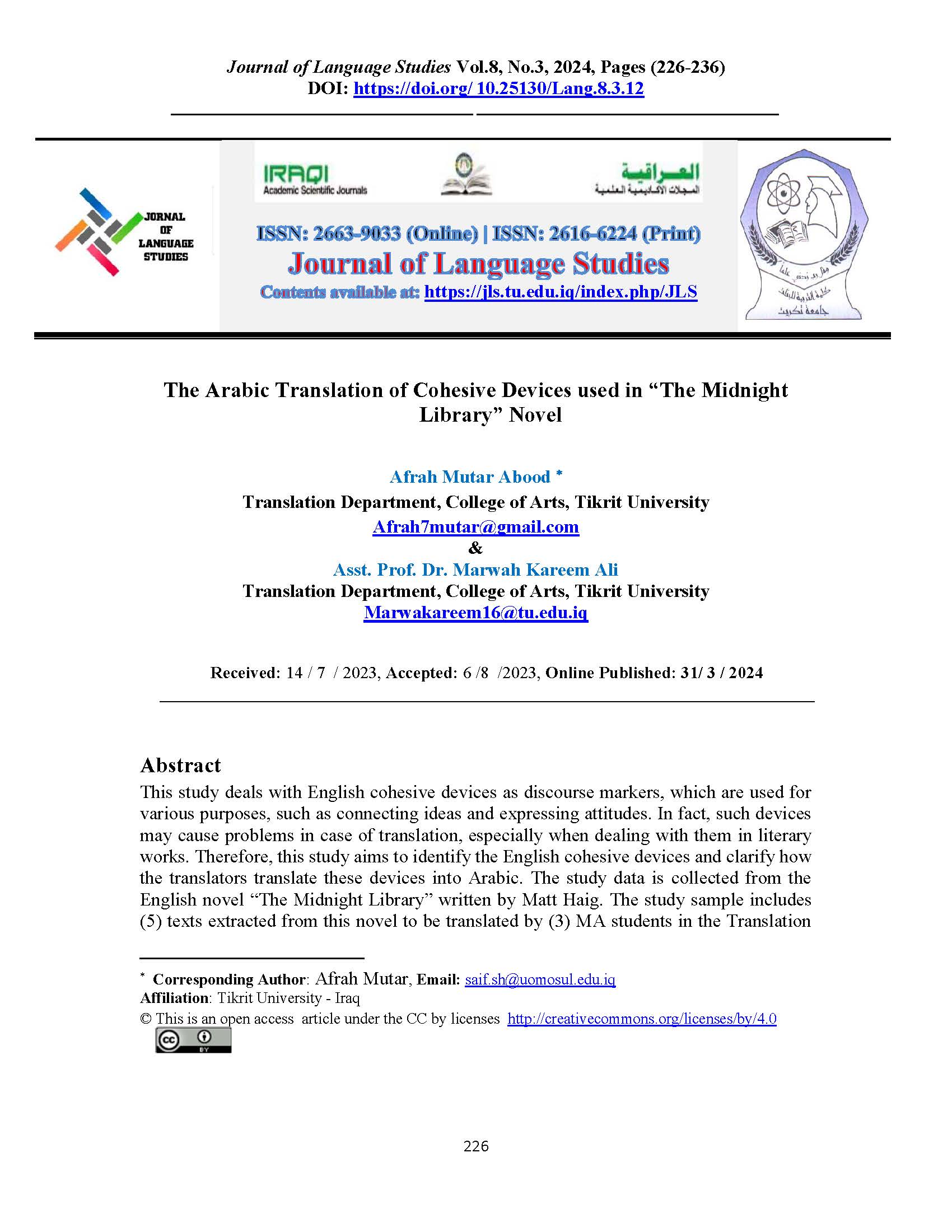The Arabic Translation of Cohesive Devices used in “The Midnight Library” Novel
Afrah Mutar Abood
Translation Department, College of Arts, Tikrit University
Marwah Kareem Ali
Translation Department, College of Arts, Tikrit University
DOI: https://doi.org/10.25130/Lang.8.3.12
Keywords: Arabic language, cohesive devices, discourse markers, literary works, translation
Abstract
This study deals with English cohesive devices as discourse markers, which are used for various purposes, such as connecting ideas and expressing attitudes. In fact, such devices may cause problems in case of translation, especially when dealing with them in literary works. Therefore, this study aims to identify the English cohesive devices and clarify how the translators translate these devices into Arabic. The study data is collected from the English novel “The Midnight Library” written by Matt Haig. The study sample includes (5) texts extracted from this novel to be translated by (3) MA students in the Translation Department, College of Arts, Tikrit University. Concerning the analysis of data, the study adopts two models: Halliday and Hasan's (1976) model for identifying the cohesive devices in the novel under study; and Newmark’s (1988) model for determining the method of translation. The study reveals that cohesive devices are used to demonstrate a semantic function rather than a communicative one, causing a challenge for translators to translate them into Arabic.
References
Aidinlou, N., Khodmard, N. & Azami, J. (2012). The Effect of Textual Cohesive Reference Instruction on the Reading Comprehension of Iranian EFL Students. International Journal of English Linguistics, 2(5), 18-24.
Aziz, A.W. (2015). Scoring Lexical Cohesion and Grammatical Cohesion: Analysis of Paragraphs in Students' Thesis. Indonesian Language and Literature. DIALECTIC: A Scientific Journal of Language, Literature, and Mathematics Education, 1(1), 71–85.
Bahaziq, A. (2016). Cohesive Devices in Written Discourse: A Discourse Analysis of a Student’s Essay Writing. English Language Teaching, 9(7),112-119
Baryadi, I. (2002). Fundamentals of discourse analysis in linguistics. Yogyakarta: Gondho Suli Library.
Bell, R. (1991). Translation and Translating: Theory and Practice. London: Longman.
Flowerdew, J., & Tauroza, S. (1995). The Effect of Discourse Markers on Second Language Lecture Comprehension. Studies in Second Language Acquisition, 17(4), 435 – 458.
Fowler, C. A., & Hodges, B. H. (2011). Dynamics and languaging: Toward an ecology of language. Ecological Psychology, 23(3), 147-156.
Galperin, I. (1981). Stylistics. USA: Longman Group Limited.
Halliday, M. & Hasan, R. (1976). Cohesion in English. London: Longman.
Hatim, B., & Munday, J. (2004). Translation: An Advanced Resource Book. London: Routledge.
Juden, W. (1994). Contemporary Thai poetry bibliography. Bangkok: Thailand Research Fund (TRF).
Kwan, L., & Yunus, M. (2014). Cohesive errors in writing among ESL preservice language learning (Monograph Series, 4, 1-6).
Levinson, S. C. (1983). Pragmatics. Cambridge: Cambridge University Press.
Mersand (1973). Contemporary Thai poetry bibliography. Bangkok: Thailand Research Fund (TRF).
Newmark, P. (1988). A TextBook of Translation. New York: Prentice-Hall.
Nida, E., & Taber, C. (1982). The Theory and Practice of Translation. Leiden: Brill.
Schiffrin, D. (1987). Discourse markers. Cambridge: Cambridge University Press.
Trebits, A. (2009). Conjunctive cohesion in English language EU documents – A corpus-based analysis and its implications. J.ESP. 04.004
Wojtasiewicz, O. (1992). Introduction to the theory of translation. Warsaw: TEPIS.
Zanettin, F., Bernardini, S., & Stewart, D. (2014). Corpora in translator education. London: Routledge.

